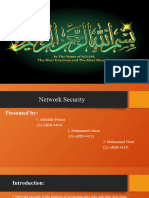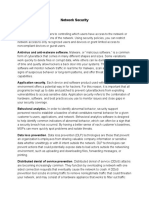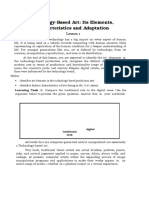u4-1
Uploaded by
muminbhatbhatmuminu4-1
Uploaded by
muminbhatbhatmuminNetwork Security Threats and Mitigation
Strategies
Introduction
As we increasingly rely on digital networks, the importance of understanding and
protecting against network security threats has never been greater. This guide will
discuss various types of network attacks, effective mitigation strategies, and useful
tools for securing networks.
Types of Network Attacks
1. Denial-of-Service (DoS) Attacks
Denial-of-Service (DoS) attacks aim to make a network service unavailable by
overwhelming it with excessive traffic. This can prevent legitimate users from accessing
the service. For example, an attacker may send a flood of requests to a server, causing
it to crash or slow down.
Mitigation Strategies:
• Rate Limiting: Limit the number of requests a single user can make in a certain
timeframe to prevent overload.
• Traffic Filtering: Use firewalls to block suspicious traffic before it reaches the
server.
• Redundancy: Deploy backup servers to ensure services remain available even if
one server fails.
2. Distributed Denial-of-Service (DDoS) Attacks
DDoS attacks are similar to DoS attacks but involve multiple compromised
systems (often part of a botnet) targeting a single service simultaneously. This makes it
harder to defend against since the traffic comes from many sources.
Mitigation Strategies:
• DDoS Protection Services: Use specialized services that absorb and filter out
DDoS traffic.
• Content Delivery Networks (CDNs): Distribute traffic across multiple servers,
reducing the load on any single server.
• Anomaly Detection: Monitor network traffic for unusual spikes that may
indicate an ongoing attack.
3. Man-in-the-Middle (MitM) Attacks
In MitM attacks, an attacker secretly intercepts communication between two
parties. This can happen, for instance, on unsecured Wi-Fi networks where attackers
can eavesdrop on conversations.
Mitigation Strategies:
• Encryption: Use protocols like HTTPS to encrypt data being transmitted, making
it difficult for attackers to read intercepted data.
• Virtual Private Networks (VPNs): VPNs encrypt all traffic between the user and
the VPN server, providing an additional layer of security.
• Public Key Infrastructure (PKI): Use digital certificates to verify the identities of
parties involved in communication.
4. Spoofing Attacks
Spoofing attacks occur when an attacker disguises themselves as a trusted entity
to gain unauthorized access. This can involve IP spoofing, email spoofing, or even DNS
spoofing.
Mitigation Strategies:
• Authentication: Implement strong authentication methods, such as multi-
factor authentication (MFA), to verify user identities.
• Email Filtering: Use SPF (Sender Policy Framework) and DKIM (DomainKeys
Identified Mail) to authenticate email senders.
• IP Whitelisting: Allow only specific, trusted IP addresses to access sensitive
systems.
5. Malware Attacks
Malware refers to malicious software designed to harm or exploit devices and
networks. This includes viruses, worms, ransomware, and spyware.
Mitigation Strategies:
• Antivirus Software: Install and regularly update antivirus programs to detect
and remove malware.
• Regular Updates: Keep operating systems and applications up to date to
protect against known vulnerabilities.
• User Training: Educate users about the dangers of downloading untrusted
software or clicking on suspicious links.
Network Security Mitigation Strategies
Network Hardening
Network hardening involves improving security by reducing vulnerabilities. Key
practices include:
• Configuring Firewalls: Set up firewalls to control incoming and outgoing traffic
based on security rules.
• Disabling Unused Services: Turn off services that are not needed, reducing
potential entry points for attackers.
• Network Segmentation: Divide the network into smaller segments to limit the
spread of a breach.
Vulnerability Scanning and Patching
Regularly scanning for vulnerabilities and applying patches is essential for
maintaining a secure network.
• Vulnerability Scanning: Use automated tools to identify weaknesses in systems
and applications.
• Patch Management: Implement a routine to apply security updates promptly to
address vulnerabilities.
Network Security Tools and Techniques
Network Sniffers
Network sniffers are tools that capture and analyze network traffic. They help
identify issues and monitor for suspicious activity. Some common sniffers include:
• Wireshark: A popular network protocol analyzer that lets users see network
traffic in real time.
• Tcpdump: A command-line packet analyzer that captures network packets for
analysis.
• Nmap: A network scanning tool that detects hosts and services on a network.
Intrusion Detection Systems (IDS)
IDS tools monitor network traffic for suspicious activity. They alert administrators to
potential threats, enabling a timely response. IDS can be classified as:
• Network-based IDS (NIDS): Monitors traffic across multiple devices on the
network.
• Host-based IDS (HIDS): Monitors individual devices for unusual activity.
Firewalls
Firewalls act as barriers between trusted and untrusted networks. They filter traffic
based on predefined security rules, blocking unauthorized access while allowing
legitimate communication.
Security Information and Event Management (SIEM)
SIEM systems collect and analyze security data from across the network in real
time. They help organizations monitor security incidents and respond more effectively.
You might also like
- OpenText Document Pipelines 16.2 - Programming Guide English0% (1)OpenText Document Pipelines 16.2 - Programming Guide English92 pages
- La Rebelión de Tupac Amaru - Charles WalkerNo ratings yetLa Rebelión de Tupac Amaru - Charles Walker307 pages
- Introduction to Network Security Basics Report 1738737712No ratings yetIntroduction to Network Security Basics Report 173873771214 pages
- An Analysis of Network Security Threats and CounteNo ratings yetAn Analysis of Network Security Threats and Counte5 pages
- LEC-5 NM Introduction to Network Security (1)No ratings yetLEC-5 NM Introduction to Network Security (1)40 pages
- Network-Attacks-and-Protection-Strategies (1)No ratings yetNetwork-Attacks-and-Protection-Strategies (1)15 pages
- Network and Device Security Awareness and ToolsNo ratings yetNetwork and Device Security Awareness and Tools54 pages
- Network Security: Compiled: Engineer M. Mago, Mba, MSC (Electronics & Automation Engineering, Telecoms)No ratings yetNetwork Security: Compiled: Engineer M. Mago, Mba, MSC (Electronics & Automation Engineering, Telecoms)16 pages
- Introduction to Cybersecurity_ Tools and TechniquesNo ratings yetIntroduction to Cybersecurity_ Tools and Techniques1 page
- 2. IT Network-Internet and Intranet-SecurityNo ratings yet2. IT Network-Internet and Intranet-Security16 pages
- Network Security - Part 1 企業網絡安全威脅: Enterprise Networks Security ThreatsNo ratings yetNetwork Security - Part 1 企業網絡安全威脅: Enterprise Networks Security Threats50 pages
- Cybersecurity Attacks and its PreventionNo ratings yetCybersecurity Attacks and its Prevention3 pages
- Presentation On Electronic Voting Machine (EVM) & Voter Verifiable Paper Audit Trail (VVPAT)No ratings yetPresentation On Electronic Voting Machine (EVM) & Voter Verifiable Paper Audit Trail (VVPAT)67 pages
- [Renewal AZ-400] sd sd Microsoft Certified_ DevOps Engineer Expert 2024No ratings yet[Renewal AZ-400] sd sd Microsoft Certified_ DevOps Engineer Expert 202410 pages
- Perc. 8 Operational Amplifier (Op-Amps)No ratings yetPerc. 8 Operational Amplifier (Op-Amps)19 pages
- ECA 4142 - Appendix 2A - Proposal Assessment - SupervisorNo ratings yetECA 4142 - Appendix 2A - Proposal Assessment - Supervisor1 page
- Computer Science Nios Senior Secondary 330No ratings yetComputer Science Nios Senior Secondary 3307 pages
- SPOOLS_Disposable-Fiber-Spool-for-Unmanned-Underwater-Vehicle_DTSRBOBUUVNo ratings yetSPOOLS_Disposable-Fiber-Spool-for-Unmanned-Underwater-Vehicle_DTSRBOBUUV2 pages
- Cauchy Euler Equations Explained - Univerity of FloridaNo ratings yetCauchy Euler Equations Explained - Univerity of Florida4 pages































































































